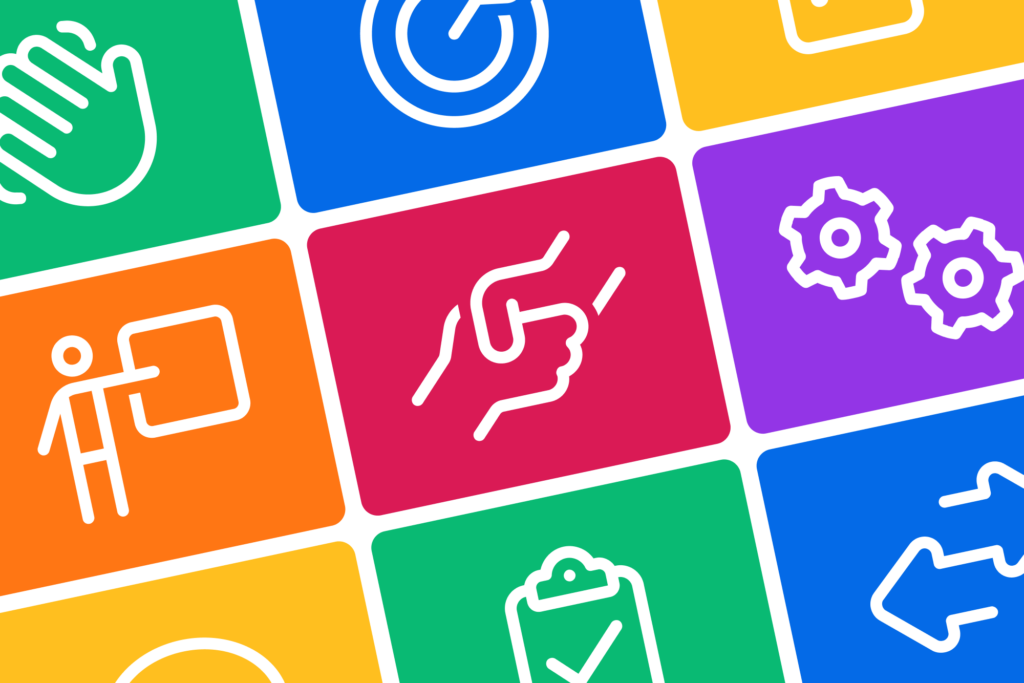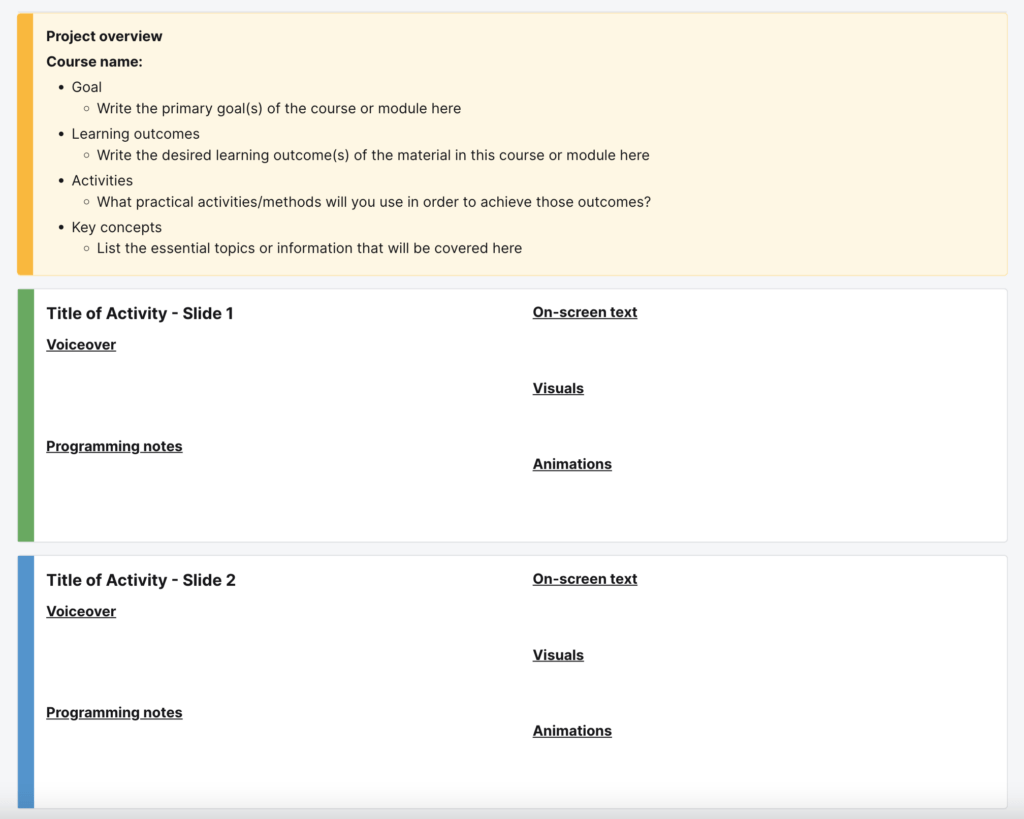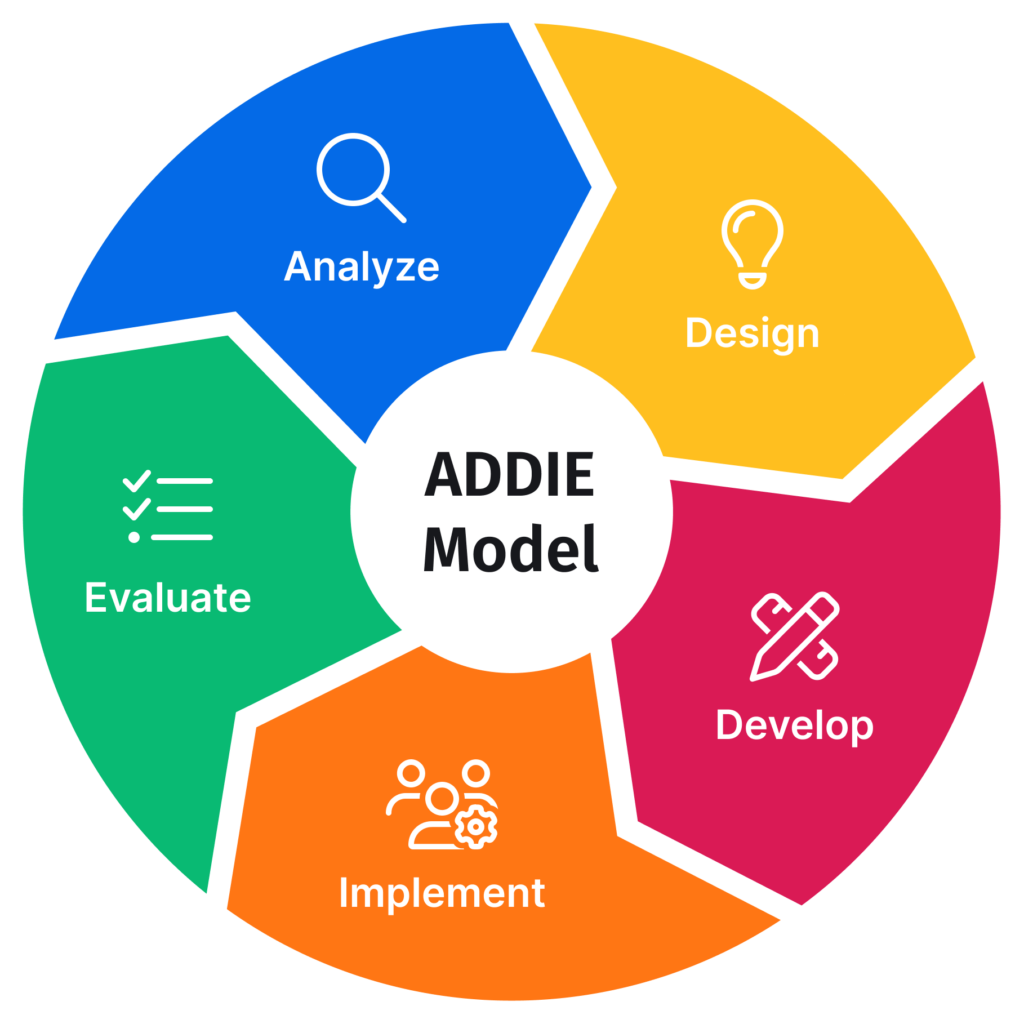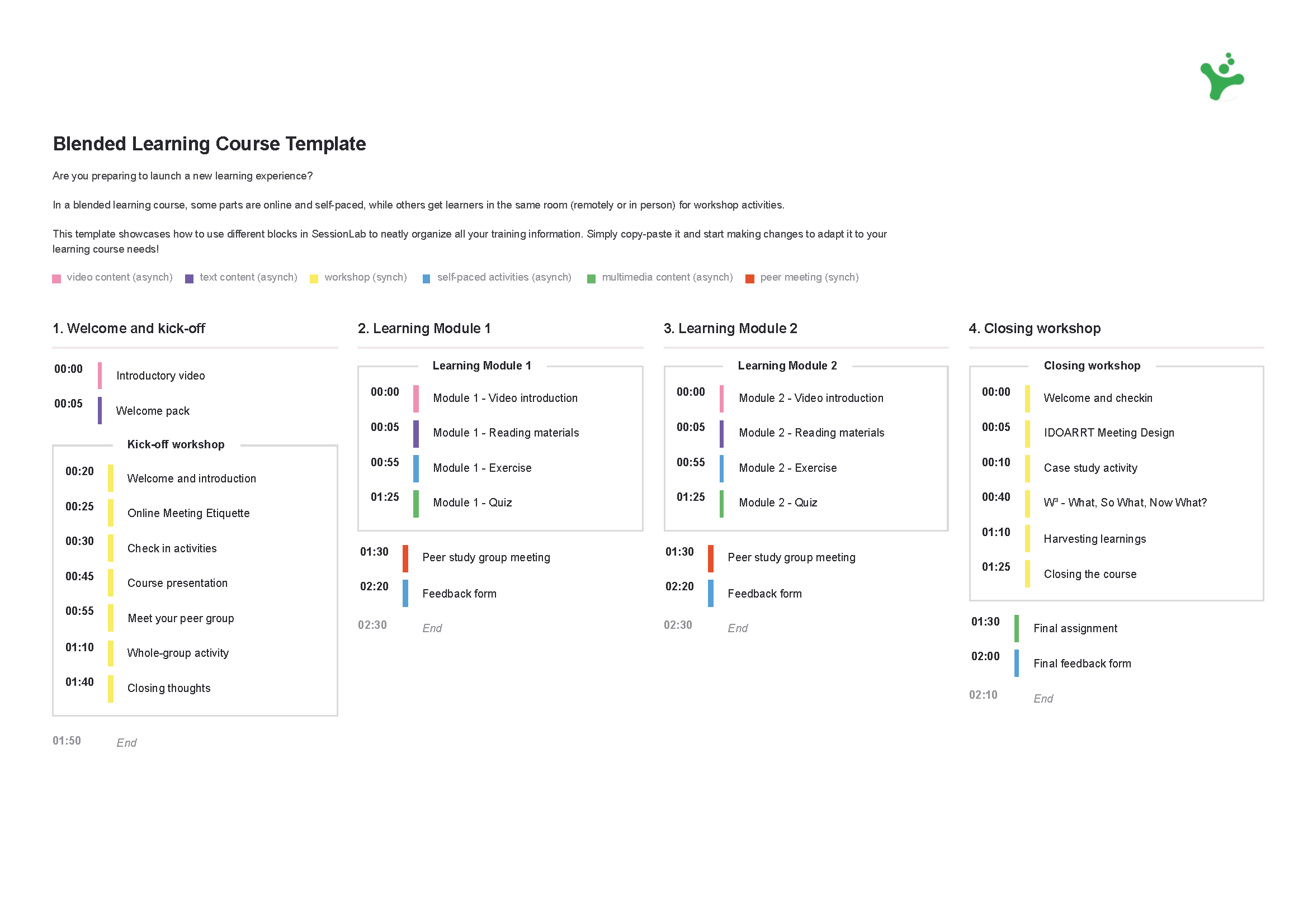

Instructional design is a systematic and theory-backed approach to creating engaging and impactful learning experiences. Whether you’re designing eLearning courses or employee training programs, effective instructional design is a surefire method of meeting business goals and developing effective learning solutions.
But what is instructional design exactly? In this guide, we'll start with a practical definition of instructional design. We'll explore the role of instructional designers, learning models and theories, and also share real-world examples and best practices to help you craft more effective learning experiences.
Join the 150,000+ facilitators using SessionLab.
Instructional design is a systematic process of designing and developing effective instructional materials and learning experiences.
Instructional design involves analyzing learner needs, designing a curriculum and learning content designed to meet those needs, implementing that design in the most effective way, and finally evaluating the effectiveness of the learning experience.
When a company sees a need to train their employees or there’s a skills gap that needs to be filled, they’ll often employ an instructional designer to analyze the issue and create an appropriate learning solution based on the desired learning goals of the project.
While instructional design is a process, this isn’t to say instructional design isn’t creative or overly rigid. In my experience, the best instructional designers use their personal style and creativity to develop eLearning or training programs that excite, engage and teach in equal measure.
In my experience, great instructional design happens when:
While I see instructional design as a profession, I also see it as a set of skills and competencies that allow for the creation of effective learning experiences. This distinction is useful for the fact that people who may not have “instructional designer” in their job title will still benefit from the theories, models and best practices of instructional design.
For me, anyone who is teaching skills or imparting knowledge can benefit from the principles and theories of instructional design.
That said, instructional design is especially useful anytime you are creating a self-paced learning experience (typically eLearning) or designing a training experience that other trainers will deliver, such as a corporate training or a train-the-trainer course.

In simple terms, an instructional designer designs and develops effective learning solutions. They’ll typically follow an instructional design process to go from a first step of determining needs, all the way through to a final stage of implementing a solution, often in the form of an eLearning course or training program.
The actual work that an instructional designer does on a day-to-day basis goes way beyond the steps of an instructional design process.
In reality, they’ll often project manage the whole process, interview and source material from subject matter experts, create outlines and storyboards, liaise with stakeholders and more.
In some cases, instructional designers will move their storyboard to eLearning authoring tools or a Learning Management System (LMS) and develop learning aids and images, learning aids, slide decks and more. Sometimes, the instructional designer may pass a completed eLearning storyboard to an eLearning developer or graphic designer to implement the course or create materials.
It’s also worth noting that in different industries and organizations, the exact role and responsibilities of an instructional designer can vary. In one company, the instructional designer may own the entire process and be the one to uncover learner needs and then deploy and monitor the solution they roll out.
In other cases, the instructional designer may receive a brief from another team member or department and design a storyboard that is then passed to someone else to implement in an internal university or course hub.
Here is an inexhaustive list of the tasks and responsibilities an instructional designer will likely perform throughout the process.

If you’re working in the development of eLearning courses and training programs, you might have heard different terms used in the field: learning design and instructional design. These terms are often used interchangeably, though I’ve found many folks have a preference on which they use and do see a distinction between them.
In my experience, whether someone says they’re an instructional designer or learning designer, they broadly mean the same thing – a person who creates engaging and effective learning experiences.
Where the distinction often comes in is in how they see the work they do, the approach they take and the usual context of their work.
Here are some of the key differences I’ve found that might be useful to think about when consider the question of what is instructional design:
So what is the difference between learning design and instructional design? Short answer: nothing, really. Slightly longer answer: it depends on context, personal outlook and approach.
In reality, much of the work these people do is the same, though they may have a different focus or mindset when it comes to designing and developing learning experiences.
In my experience, this is more often dependent on the industry, job role or project than on the distinction between learning design vs instructional design. That said, I do find the question is interesting when it comes to thinking about the work we do as instructional designers and where our focus should be.
Do you see a distinction or have something to add? We’d love to hear from you in the comments!
Whether we’re talking about instructional design or learning design, the learning experiences we create are built on a foundation of effective learning principles, models and theories.
So what are they? Instructional design models often comprise a series of steps designed to create an effective learning experience. Think of instructional models as a proven process an instructional designer may follow in order to develop and project manage an instructional design project.
By following a model, you have a framework creating an effective learning experience and can ensure nothing is missed and that your learning solution is fit for purpose.
Instructional design theories and principles are a collection of learning theories, psychological knowledge and conceptual frameworks that underpin effective learning experiences. In practice, this is a combination of utilizing good pedagogical (and andragogical) practices, learning science and models of learning to inform the experiences and materials you design.
In practice, many instructional design models and theories overlap and are often utilized in the same way – by providing a set of guidelines to follow in order to create an effective instructional design.
So how do you choose one? Early in your instructional design journey, you’ll likely find a model or theory that chimes with your own learning experiences and style. (The ADDIE model and Robert Gagne’s events of instruction are popular for good reason!)
You’ll likely find that you organically use many of these concepts in your work anyway – it’s quite common to discover a learning concept and think, “Oh, I already do this!”
That said, a deeper understanding of how these principles and instructional design models work in tandem can only improve your practice and the quality of your training materials.
As you learn and develop as an instructional designer, I’d highly recommend exploring multiple instructional design models and theories to deepen your knowledge and synthesize best practices from each.
Here are some of the most prominent instructional design models and theories you can use to inform your learning design process.
The ADDIE (Analysis, Design, Development, Implementation, Evaluation) model is a systematic approach to instructional design widely used in educational and corporate settings.
ADDIE a proven five step process for developing instructional designs that truly meet learner needs and is probably the most well known model in the field. The five steps of the ADDIE model are:
This is where the instructional designers conduct a needs assessment, discover skills gaps and get to know the audience of the online courses and learning resources they may design. You may also conduct research into the needs of the business and the wider space surrounding your potential training.
During the design step, instructional designers begin to ideate on a learning solution designed to meet the needs identified during analysis. You’ll typically create a course outline, craft learning objectives and create an overall structure of your learning process in the form of a storyboard.
Here, you’ll set out to answer any questions about the course or learning experience you’re creating and demonstrate how you’ll meet your goals in order to get approval to move forward.
In the development phase of ADDIE, instructional designers create a storyboard for their chosen learning solution. You’ll also work with subject matter expert to source course content and graphic designers to create course materials.
Once you’ve drafted a storyboard that sings, you’ll often take a different route depending on whether you’re working an online courses or in-person training.
In an eLearning environment, you’ll likely use eLearning authoring tools to create final assets ready to deliver to learners. For in-person training, you’ll likely create instructional manuals or training guides to help in-person trainers lead the program effectively.
In this step of the instructional design process, you’re about ready to deliver your instructional materials to learners!
Here, you’ll set up the final learning experience in a learning management system, deliver training directly and distribute other material as necessary. This can also look handing over storyboards to another team to implement or having workshops with trainers and facilitators who will deliver the instructional design content.
Once your learning solution is out in the world, you’ll need to evaluate whether you met your goals and analyse the impact of what you’ve done. Here, you’ll likely look at how learners engaged with your materials while also consider the impact you’ve had on business goals.
The aim is to understand whether you’ve solved the problem or closed the skills gap identifying in your needs assessment and also figure out how you might improve your learning solutions for future learners.
ADDIE is easy to use and is often the first model turned to for even the most complex projects and instructional design processes. Read more in our complete guide to using the ADDIE model or jump into creating your next instructional design with our ADDIE template.

The SAM model (Successive Approximation Model) is an agile instructional design model that focuses on rapid prototyping and iterative development. It encourages collaboration between stakeholders and allows for quick feedback and revisions throughout the design process.
SAM has three distinct phases.
In the preparation phase, instructional designers gather background information on learners and seek to understand learner needs, the knowledge and skills they already possess and the skills your team would like them to achieve.
During the iterative design phase, instructional designers will begin planning the learning solution in earnest before designing, prototyping and evaluating the chosen solution over successive rounds of iteration. The goal is to iterate openly and get regular feedback throughout the process.
Finally, in the iterative development phase, learning designers will seek to quickly implement a solution with their choice of instructional technology.
The alpha, beta and gold versions of their instructional design will each go through a round of testing with SMEs, stakeholders and representative users in order to create the best possible solution as quickly as possible.
Prototyping is the name of the game here, and as a result, SAM is a rapid instructional design system that’s a natural alternative to ADDIE for teams who want to move and iterate quickly.
Read more about using the SAM model in our guide to instructional design models.
Developed as a deeper exploration of ADDIE designed to help newcomers, the Dick and Carey model of instructional design is a great way to consider the wider context of a learner’s experience. It comprises of ten steps which include:
Personally, I found the Dick and Carey model a great tool when starting out in instructional design. It made certain parts of the process more explicit and helped me see the process of developing an instructional design as an often non-linear system than the straight line that ADDIE might imply.
Bloom’s taxonomy categorizes how we learn into six levels of cognitive complexity, ranging from simple recall to critical thinking and creativity. Instructional designers and educators use Bloom’s Taxonomy to design learning activities that address different cognitive levels and guide learners towards mastery of a topic or skill.
Bloom’s taxonomy is heavily informed by educational psychology and comprises of three learning domains: cognitive (knowledge), affective (feelings), and psychomotor (skills).
Those learning domains underpin the six levels of bloom’s taxonomy. In the 1956 version of bloom’s taxonomy, those are:
Starting with the first step, learners will demonstrate their mastery of one level of learning before moving to the next. Note that a revised version of Bloom’s taxonomy was also created in 2001 to respond to the more dynamic nature of learning.
The six stages of Bloom’s revised taxonomy are:
Each stage in the hierarchy of Bloom’s taxonomy also comes with its own set of verbs and questions that learning designers can use to easily create learning objectives and inform their instructional design.
While some learning designers might use Bloom’s Taxonomy to guide their course structure, it’s also a useful tool to use in tandem with other theories and models. If you have trouble with creating learning objectives or setting meaningful and measurable goals for your instructional designs, definitely look deeper into Bloom’s taxonomy.

Gagne’s principles of instructional design is a set of learning events that comprise an effective learning experience. Beginning with gaining learner attention and ending with assessment and learner retention, these 9 events can be used as both the structure of an effective online course and an underlying theory that helps you ensure the learning experience is engaging.
Gagne’s 9 events of instruction are:
Gagne’s principles have been especially useful in my own practice. I often use the 9 events as a basic course outline or storyboard that I’ll build upon as I move through the stages of the ADDIE model.
On other occasions, I’ll think about how I’ve implemented the 9 events while revising my design and make changes based on Gagne’s principles. Check out our guide to explore these instructional design principles in greater detail and learn how to deploy them in eLearning and instructor-led-training.
Note that these instructional design theories are only a small sample of the entire field of instructional design.
We encourage you to explore and find theories and models that resonate with your personal style while helping you develop your foundation of learning knowledge. Our piece on instructional design models is a great next step on that journey!
I also found this post on fundamental learning theories from Structural Learning helpful when considering how to practically apply theory into my designs.
At this stage, you might be wondering what instructional designers end up creating for the clients and companies they work with.
Instructional design principles are applied across various domains, including education, corporate training, personal development, and more to create everything from learning simulations, training courses, employee onboarding and traditional eLearning.
Here are some examples of instructional design in action with a template for each you can use and adapt when developing your own learning solutions.
Instructional designers are often called upon to create interactive eLearning in the form of online courses and online training programs. Typical eLearning projects are mostly self-paced in nature and will include multimedia elements, quizzes, and simulations to enhance learning outcomes.
In addition to traditional long-form course, eLearning can also come in the form of micro-learning, entirely gamified experiences, simulations and more. Instructional designers create a variety of different materials and will deploy a particular format of eLearning based on learner needs and the remit of the project.
eLearning will often be delivered to solve a training need, onboard new employees or develop key skills or knowledge. After an instructional designer has created the course design in the form of a storyboard, this will then be developed into a finished course. Depending on the client and department, completed eLearning might live in an internal learning hub or learning management system or be delivered to a public course platform.
Curious to see what this looks like for an instructional designer? Explore this example of an eLearning course storyboard I delivered for a client. After delivery of the storyboard, I handed the design to an eLearning developer who then implemented the design in their LMS.

In corporate settings, instructional designers often develop training programs to onboard new employees, upgrade skills, or promote workplace safety. These programs often incorporate scenario-based learning, role-playing activities, and real-world simulations to provide hands-on experience.
A key distinction here is that instructor-led training is often conducted in real-time, with an experienced trainer leading the session for trainees. Traditionally, this was in a live setting where trainees all attended in person, but these days, virtual training is increasingly frequent.
The instructional designer will create training materials, design an effective training flow and then brief trainers on how the training should be delivered. They’ll often also create facilitator guides, instructional manuals, job aids and learning materials to help aid the delivery and retention of training courses.
Explore this guide on how to create an engaging training session to learn how to plan and design effective employee training and more!

Blended learning courses and cohort-based online learning are learning experiences that feature some combination of self-paced learning and live, facilitated content. Instructional systems design is highly useful in such scenarios, as the balance of experiences needs to be finely tuned.
Here, learners typically engage with self-paced eLearning content alongside live workshops and training sessions. Trainers may introduce the blended course with an introductory meeting and then run live workshops or presentations at various points in the program. Often, learners will join such a program in a cohort of other learners that they can interact with in social spaces or even in peer-learning activities.
Blended learning design can often combine the best of sync and async learning environments, but it can also be a challenging balance to strike. You’ll need to deploy a variety of instructional technology, often providing opportunities for hybrid learning and virtual facilitation too.
Learn more in this guide to blended learning design or see what a design might look like in practice in this blended learning course template.

The field of instructional design/learning design/learning experience design has existed in some form for decades. Well before the invention of eLearning and advanced instructional technology, academics, psychologists and designers established learning theories and best practices that persist to this day.
Combine this body of existing learning knowledge with the best parts of modern instructional design and you can bolster your practice and inform any learning design process you’re working on. Here’s an in-exhaustive list of some instructional design best practices I’ve learned while creating my own courses and researching the topic.